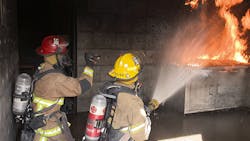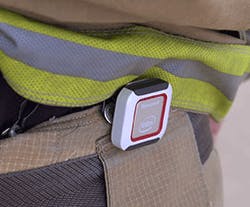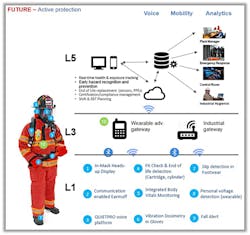Honeywell and Intel have joined forces to create and demonstrate a prototype of a personal, connected, safety solution for industrial workers and first responders that could reduce workplace injury and improve productivity. The prototype was shown at Intel’s Internet of Things (IoT) Insights Day Nov. 3 in San Francisco, an annual showcase featuring innovative IoT hardware and software in development by Intel and partnering companies.
According to Honeywell and Intel, the prototype provides safety intelligence that reduces worker injuries and prevents loss of life from “man-down” scenarios, improving productivity and reducing equipment failures.
“This collaboration between Honeywell and Intel showcases how we are connecting industrial workers to the digital world and creating safer work environments,” said Carl Johnson, president of Honeywell Industrial Safety. “Honeywell’s long history in sensing technologies enables us to utilize environmental data to reduce risks and increase the productivity of our customers by using technology and staying connected to workers. This is a major breakthrough for worker safety and productivity that will revolutionize the industrial workplace.”
The Honeywell Connected Worker solution includes a mobile hub that collects and provides sensor fusion, which refers to data collected from a variety of sensors on a worker that are compiled to provide a broader and more accurate picture of what that worker is experiencing. The mobile hub pulls data from a self-contained breathing apparatus (SCBA), a heart rate monitor and several Intel Quark SE microcontroller-based devices, including a toxic gas monitor, an activity detection device and a non-verbal gesture device.
The solution monitors workers for toxic gas exposure, breathing, heart rate, posture and motion. The resulting data and actionable intelligence is displayed remotely on a visual, cloud-based dashboard, giving plant managers and incident commanders the information needed to better anticipate unsafe conditions and prevent potential “man-down” scenarios that could threaten worker safety. In addition, the data can be used to prevent equipment failure that could create unsafe conditions or costly downtime.
“The joint use case from Honeywell and Intel demonstrates an industrial wearable solution for a connected worker to help protect workers from unexpected and previously undetected risks in industrial environments,” said Doug Davis, senior vice president of the Intel IoT Group. “[It] is a great example of an edge-to-enterprise solution that validates how real-time information can be turned into potentially life-saving actions.”
The demonstration teamed the strengths of both companies’ offerings by creating a centralized command center for managing safety data. A cloud-based service connects the multiple devices, systems and data sources, and then streamlines data collection to give safety managers an integrated view of safety and compliance that is accessible from a web browser.
About the Author

Sandy Smith
Sandy Smith is the former content director of EHS Today, and is currently the EHSQ content & community lead at Intelex Technologies Inc. She has written about occupational safety and health and environmental issues since 1990.


